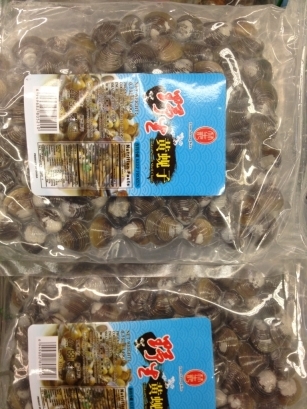|
|||||
Freshwater Molluscan Shells: food in modern timesBesides their use as foods by primitive peoples, freshwater mollusks are eaten in large parts of the Far East and by Oriental peoples worldwide. Corbicula clams and various snails are now shipped overseas from China and Vietnam, and are available in many Asian grocery stores in other parts of the world.
Liu Yueyin (1979) describes Corbicula in China as delicious, of high nutritional value, and inexpensive. Corbicula are produced dry, salted, and canned, and are farmed in Fujian Province. According to the nutritional analysis she includes, they contain 5.3 % protein, 2 % fat, 7% carbohydrates, 85 % moisture, 0.7 % ash, 133 mg Calcium, 92 mg Phosphorus, 2.5 mg Iron, 1900 IU vitamin A and 0.4 mg riboflavin. More information about their use and culture can be found at http://www.cabi.org/isc/datasheet/88200
Packaged Corbicula clams can now (2015) be found in the frozen foods sections of larger Asian groceries throughout the United States.
These are labeled as "small shell clams" and a product of China. There is also a "baby clam" size available imported from Vietnam. Packages were $2.79 for the 340 g "12 oz." larger shell size and $3.89 for a 400g "14 oz." package of "baby" clams.
Listed nutrition facts from the package per 100g:
71 Calories, 1.7g total fat, 0g saturated fat, 0g trans fat 146 mg cholesterol, 1770.5 mg sodium, 8.9g total carbs, 0g dietary fiber, 0g
sugars, 4.8g protein, 10% dv vitamin C, 39% dv calcium, and 11.4% dv iron. The high sodium value suggests the addition of salt, even
though it is not shown as an ingredient.

Bags of frozen Corbicula clams and viviparid snails carried by Asian food stores in the United States. The clams
are additionally sold in a "baby" size, about half the size of those pictured.
Liu Yueyin (1979) also describes the consumption of snail species in China. Of the viviparidae, Cipangopaludina chinensis and cathayensis are widely distributed, and primarily eaten in the southern provinces. The muscular foot is described as delicious meat with a high nutritional value, and she mentioned that they were being exported frozen. Nutritional information given therein for a 100 gram edible portion: 10.7g protein, 1.2g fat, 5.8g sugar, 1357mg calcium, 191mg phosphorus, 19.8mg iron, 130 IU vitamin A, 0.17mg riboflavin, 2.2mg niacin, and 69 Calories.
According to Liu Yueyin, Pila snails (ampullariidae) are also eaten in their area of distribution in China, Hainan Island and elsewhere. as with Corbicula, these snails are still produced and exported, and can be found in specialty stores in urban areas throughout the world.
Packages of frozen ampullariid snails, Pila polita, offered in another Asian grocery store, product of Vietnam. Nutritional information from the package for 140 grams: 116 Calories, 40 Calories from fat. Total fat 4g. Saturated fat 0g. Cholesterol 0mg, Sodium 0g, Total carbohydrates 0g, Dietary fiber 0, vitamin A 0% DV, Vitamin C 0% DV, Calcium 2% DV. Protein 20g.
Dishes
A large number of pictures are available on the Internet, many with Creative Commons licenses through the Wikimedia Foundation taken by people doing cultural research and tourists amazed at what they find themselves eating. A few examples below.
Vietnam
Tomato and snail based noodle soup topped with scallions (Bun oc).
Photo by Nguyen Thanh Quang via Wikimedia Commons
Stuffed snails, (ốc bươu nhồi thịt) photo by Nguyen Thanh Quang via Wikimedia Commons.
Cơm hến, baby Corbicula with leftover rice, served at room temperature, a rice dish originating in Hue, Vietnam. Photo By Lucas Jans Creative Commons], via Wikimedia.
Cambodia
Plate of freshwater snails, including both a viviparid species, and a larger ampullarid species, probably an invasive Pomacea. Poipet, Cambodia. Photo Albiero Rodas via Wikimedia Commons.China
The Chinese dish Luosifen (螺蛳粉) is a specialty of Liuzhao in southern China, but is becoming available more widely in China and elsewhere. It consists of rice noodles boiled and served in a stock made from river snails (viviparid species) and pork bones with vegetables and various seasonings. It does not usually contain snail meat, but the snails may be served as a side dish.
Luosifen served in Wudaokou, a district of Beijing. Photo by User N509FZ, Creative Commons via Wikimedia.Liu Yueyin (1979) Economic Fauna of China (Freshwater Mollusks) Hyayu Center for Environmental services, Beijing. 134 pp. (In Chinese, but with Latin names in Roman characters.)